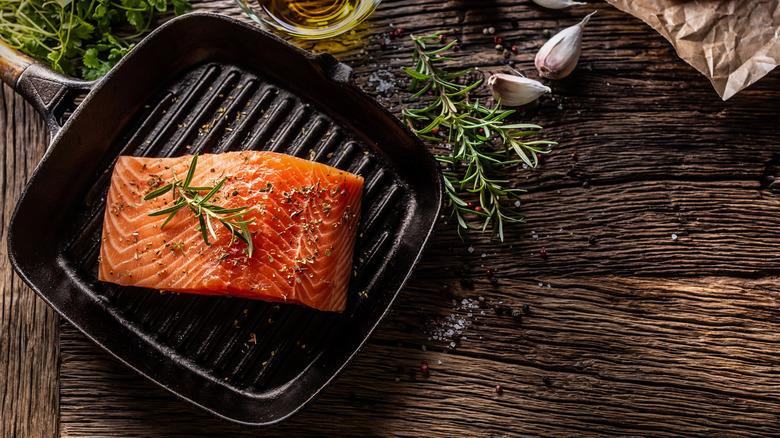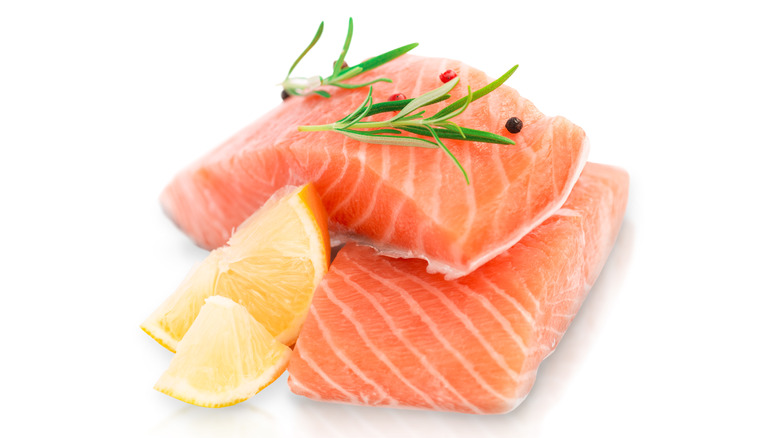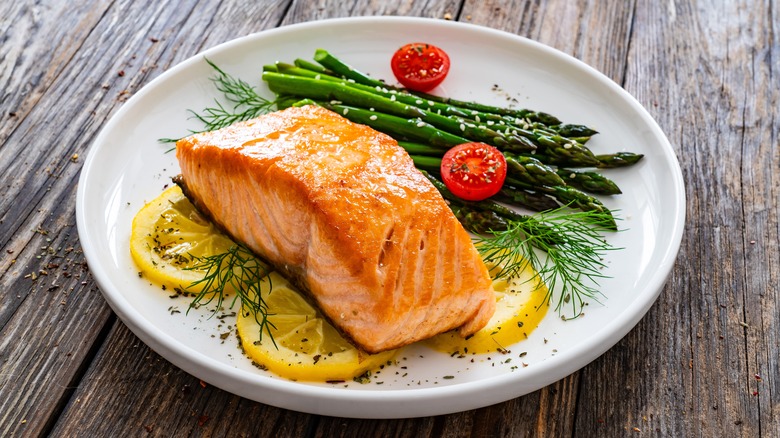Should You Be Washing Your Salmon Prior To Cooking?
Salmon has become one of America's most consumed seafood products, just behind shrimp and tuna. As more home cooks explore cooking techniques for the best salmon flavor, questions about proper handling persist — especially whether it should be rinsed before cooking. According to the U.S. Department of Agriculture (USDA), raw meat and poultry shouldn't be washed as it can cause cross-contamination. This applies to salmon and other fish as well.
Rinsing the protein under running water can cause bacteria on its surface to spread to other parts of the fillet and kitchen surfaces, potentially leading to illness. Multiple bacteria and illnesses have been linked to raw fish including salmonella, listeria, and norovirus.
Washing meats used to be a popular method to remove visible dirt. However, current FDA regulations have stricter safety procedures regarding cleaning, handling, and packaging that alleviate this need. The best way to avoid bacteria is to wash your hands before handling the raw fillet and pat it dry to remove any extra moisture before cooking. Also, according to the USDA, fish and shellfish should be cooked to an internal temperature of 145 degrees Fahrenheit to rid any lingering germs and be considered safe to eat.
Key steps to get your salmon ready for cooking
Before cooking your salmon, there are several factors to consider to get the best-tasting fish — starting at the store. There are multiple varieties, each with its specific flavor profiles and characteristics. Meaty king salmon has a high fat content and omega-3s; sockeye salmon has a bright red color, a stronger fishy flavor, and a firm texture; pink salmon, the most affordable option, has a milder taste and lower fat content, and is often found canned or used in recipes requiring lighter flavors.
Additionally, you may want to consider whether you prefer wild-caught or farm-raised salmon. The two types have different nutritional values due to their distinct diets — wild-caught tends to have higher mineral levels while farm-raised tends to be fattier. When buying fresh salmon, always look for a bright color and a fresh sea smell.
For storage, keep fresh fish in the coldest part of your fridge if you plan to cook it within a day or two; otherwise, freeze it in a sealed bag or airtight container. While salmon bought in the freezer section tends to be deboned, always check it to avoid any unpleasant surprises. To do so, let it thaw and then look for the bones hidden in the thin white lines across the fillet. You can pull them out with tweezers or you gently dig the tip of a knife in the lines and pull it up to take out the bones.
How to cook the tastiest salmon
Salmon can be prepared in various ways to suit different tastes and occasions. A common and delicious cooking technique is stovetop grilling. With this method, use a non-stick pan to prevent the fillet from breaking apart. Wait to add spices once the salmon is on the pan to avoid burning them immediately. If you want to try something new, consider making salmon en papillote. This French technique involves wrapping the fillet in parchment paper with herbs and vegetables and letting it steam in for a tender result.
You may also consider cooking salmon in the air fryer or oven. For example, salmon burgers are an easy and delicious choice that can be made with an air fryer. Oven-baked salmon is another great alternative, especially if you let the fish marinade for 15-20 minutes beforehand.
While you should cook the fish well to kill off bacteria, overcooking it can lead to dryness and lack of flavor. To test whether the fillet is ready to serve, gently press it with your finger or a fork and see if it starts opening up at the white lines. If it does, take it off the flame immediately so it doesn't overcook. However, if you're already stuck with overcooked salmon, turn it into a salmon salad with mayo and Dijon or add it to a curry.



